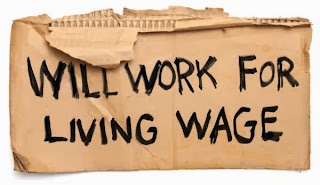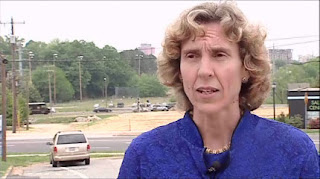
(Insight on the job market and economic recovery, with Larry Summers and CNBC's Maria Bartiromo.)
Visit msnbc.com for Breaking News, World News, and News about the Economy
More job losses expected.
Visit msnbc.com for Breaking News, World News, and News about the Economy
Nation sheds more jobs than expected
The U.S. unemployment rate rose to 9.8 percent in September, the highest since June 1983, as employers cut far more jobs than expected.
The report shows that the worst recession since the 1930s is still inflicting widespread pain and underscores one of the biggest threats to the nascent economic recovery: that consumers, worried about job losses and stagnant wages, will restrain spending. Consumer spending accounts for about 70 percent of America's economy.
Most analysts expect the economy to continue to improve, but at a slow, uneven pace. Government stimulus efforts, such as the Cash for Clunkers auto rebates, likely boosted the economy in the July-September quarter, but economists worry that growth will slow once the impact of such programs fades.
"Consumers ... are going to struggle to increase their income," said Brian Fabbri, North American chief economist for BNP Paribas. "If they're struggling, they're not consuming. That just takes some of the legs out of recovery."
The Labor Department said Friday that the U.S. economy lost a net total of 263,000 jobs last month, from a downwardly revised 201,000 in August. That's worse than Wall Street economists' expectations of 180,000 job losses, according to a survey by Thomson Reuters.
The unemployment rate rose from 9.7 percent in August, matching expectations.
If laid-off workers who have settled for part-time work or have given up looking for new jobs are included, the unemployment rate rose to 17 percent, the highest on records dating from 1994.
All told, 15.1 million Americans are now out of work, the department said. And 7.2 million jobs have been eliminated since the recession began in December 2007.
The department said 571,000 of the unemployed dropped out of the work force last month, presumably out of frustration over the lack of jobs. That sent the participation rate, or the percentage of the population either working or looking for work, to a 23-year low.
The unemployment rate would have topped 10 percent if the labor force hadn't shrank, Fabbri said.
Older, laid-off workers are dropping out and requesting Social Security at a faster-than-expected pace, according to government officials. The Social Security Administration said earlier this week that applications for retirement benefits are 23 percent higher than last year, while disability claims have risen by about 20 percent.
Meanwhile, the number of people out of work for six months or longer jumped to a record 5.4 million, and they now make up almost 36 percent of the unemployed — also a record.
Persistent joblessness could pose political problems for President Barack Obama, who pushed through an ambitious $787 billion stimulus package in February intended to "save or create" 3.5 million jobs by the end of 2010.
"We still think the overall trend is moving in the right direction," said Christina Romer, chair of the President's Council of Economic Advisers. "We're going from much larger job losses earlier this year. They are moderating. We want them to moderate more."
Republicans note that job losses have continued despite the stimulus. "Wasteful government spending is not the solution to what ails this economy," said Indiana Rep. Mike Pence, chairman of the House Republican caucus.
Federal Reserve Chairman Ben Bernanke said Thursday that even if the economy were to grow at a 3 percent pace in the coming quarters, it would not be enough to quickly drive down the unemployment rate. Bernanke said the rate is likely to remain above 9 percent through the end of 2010.
Besides the sagging jobs market, other potential obstacles to a smooth recovery include wary consumers, the troubled commercial real estate market, and a tight lending environment for individuals and businesses, said Eric Rosengren, president of the Federal Reserve Bank of Boston.
"These challenges will likely make the recovery rather restrained by historical standards, with subdued levels of spending and lending continuing to hold back a more rapid recovery," Rosengren said in a speech in Boston on Friday.
Against that backdrop, key monetary and fiscal policy supports will need to be keep in place to help foster a recovery, Rosengren said.
Hourly earnings rose by a penny last month, while weekly wages fell $1.54 to $616.11, according to the government data.
The average hourly work week fell back to a record low of 33 in September. That figure is important because economists are looking for companies to add more hours for current workers before they hire new ones.
The uncertainty that surrounds the recovery has made employers reluctant to hire. The Business Roundtable, a group of CEOs from large corporations, said earlier this week that only 13 percent of its members expect to increase hiring over the next six months.
While job losses have slowed since the first quarter of this year when they averaged 691,000 a month, the cuts actually worsened last month in many sectors compared with August.
Construction jobs fell by 64,000, more than the 60,000 eliminated in August. And service sector companies cut 147,000 jobs, more than double the 69,000 in the previous month. Retailers lost 38,500 jobs, compared to less than 9,000 in August.
Government jobs fell 53,000, the report said, with local governments cutting the most.
One the bright side, temporary help agencies eliminated only 1,700 jobs, down from the previous month. Economists see temporary jobs as a leading indicator, as employers are likely to hire temp workers before permanent ones.
Tig Gilliam, CEO of Adecco North America, a temporary job agency, said the industry likely will add jobs next month.
According to a separate report Friday, U.S. factory orders fell in August by the largest amount in five months.
The Commerce Department said demand for manufactured goods dropped 0.8 percent, much worse than the 0.7 percent gain that economists had expected. The August decline reflected plunging demand for commercial aircraft, a category that surged in July.
Washington Doesn't Get It: We Need More Jobs
Nowhere is the massive disconnect between Washington D.C. and the rest of the country more striking than when it comes to the issue of jobs.
Inside Washington, it is almost universally considered a foregone conclusion that unemployment will remain near, at, or even above 10 percent -- not just for months, but for years to come. (The unemployment rate in September, we just found out this morning, ticked up yet again, to 9.8 percent.) As White House economic guru Larry Summers dispassionately told reporters last month (while otherwise taking credit for turning the economy around), "The level of unemployment is unacceptably high and will on all forecasts remain unacceptably high for a number of, for a number of years."
This situation creates no sense of urgency in Washington. Ask Summers what he's going to do about it, for instance, and he hems and haws about recovery act programs that have yet to take full effect. To our political elite, jobs are simply nowhere near as critical an issue as the other economic indicators, the stock market, or the financial health of the nation's top bankers.
Outside the Beltway, however, it's a different story. According to a new poll by Hart Research Associates for the Economic Policy Institute, unemployment and the lack of jobs "remains the dominant problem on the economic agenda for voters across party lines." In fact, it's not even close. Asked to name the most important economic problem facing the country, registered voters cited unemployment twice as often as they mentioned the deficit or even the cost of health care; and four times as much as the housing crisis or problems with the banking system.
A whopping 83 percent see unemployment as either a fairly big or very big problem; and 81 percent say the Obama Administration hasn't done enough to deal with it.
And there just aren't a whole lot of things that more than 80 percent of Americans agree about.
Not coincidentally, large majorities of voters also see the government's economic policies as helping banks and Wall Street -- while few see themselves or average working families in general as benefiting.
So why isn't political Washington fully engaged in addressing the unemployment problem? For the same reasons it can't seem to get much of anything done these days: most notably the abject lack of boldness from the Democrats and persistent obstructionism from the Republicans.
Democrats have been particularly terrified for decades now of doing anything that can be said to actually cost the government money. (Republicans, ironically, have no such scruples.) So our modern ruling party has found itself boxed in by its own president's support for "pay-as-you-go budget rules". And the fact is that very serious concern about the deficit -- even now, when it's the least of our troubles -- is considered a hallmark of serious thinking in Washington. Those who don't toe the line are written off as crazy, wild-eyed radicals.
There are, of course, lots of ways Washington could affirmatively and effectively create jobs in short order -- if the political will were there. Direct jobs programs are the most obvious way, but reduced unemployment could also be achieved by increasing pass-through payments to the states, creating new tax incentives for boosting staff, or appropriating more money for infrastructure and environmental programs that would, in turn, lead to private-sector hiring.
New York Times opinion columnist Paul Krugman writes today, warning of Washington complacency:
[A]ll indications are that unless the government does much more than is currently planned to help the economy recover, the job market -- a market in which there are currently six times as many people seeking work as there are jobs on offer -- will remain terrible for years to come.....
[C]an we afford to do more -- to provide more aid to beleaguered state governments and the unemployed, to spend more on infrastructure, to provide tax credits to employers who create jobs?
Yes, we can.
The conventional wisdom is that trying to help the economy now produces short-term gain at the expense of long-term pain. But ... from the point of view of the nation as a whole that's not at all how it works. The slump is doing long-term damage to our economy and society, and mitigating that slump will lead to a better future.
And former Clinton labor secretary Robert Reich is also blunt, writing in his Huffington Post blog:
Who's going to buy the stuff we make or the services we provide, and therefore bring jobs back? There's only one buyer left: The government.
Let me say this as clearly and forcefully as I can: The federal government should be spending even more than it already is on roads and bridges and schools and parks and everything else we need. It should make up for cutbacks at the state level, and then some. This is the only way to put Americans back to work. We did it during the Depression. It was called the WPA.
Yes, I know. Our government is already deep in debt. But let me tell you something: When one out of six Americans is unemployed or underemployed, this is no time to worry about the debt.
But the political will simply doesn't exist. And that's a tragedy. Because the gigantic production shortfall that continues to afflict our nation is not abstract. It is made up of people -- people who are out of work, families who are losing their homes and health insurance, young people who are dropping out of college and children who are going hungry. This is the real drama of modern American life, barely registering in Washington where what matters most is political consequences -- and where the bigger danger, for now, is seen in action than in inaction.
But inaction will have consequences, too, and they could be severe. As Reich astutely warns:
Unemployment of this magnitude and duration also translates into ugly politics, because fear and anxiety are fertile grounds for demagogues wielding the politics of resentment against immigrants, blacks, the poor, government leaders, business leaders, Jews, and other easy targets. It's already started. Next year is a mid-term election. Be prepared for worse.
View Larger Map
Sources: Huffington Post, NY Times, ABC News, MSNBC, White House, Economic Policy Institute, PBS, Peter D. Hart Research Associates, Google Maps




































































.jpg)























No comments:
Post a Comment